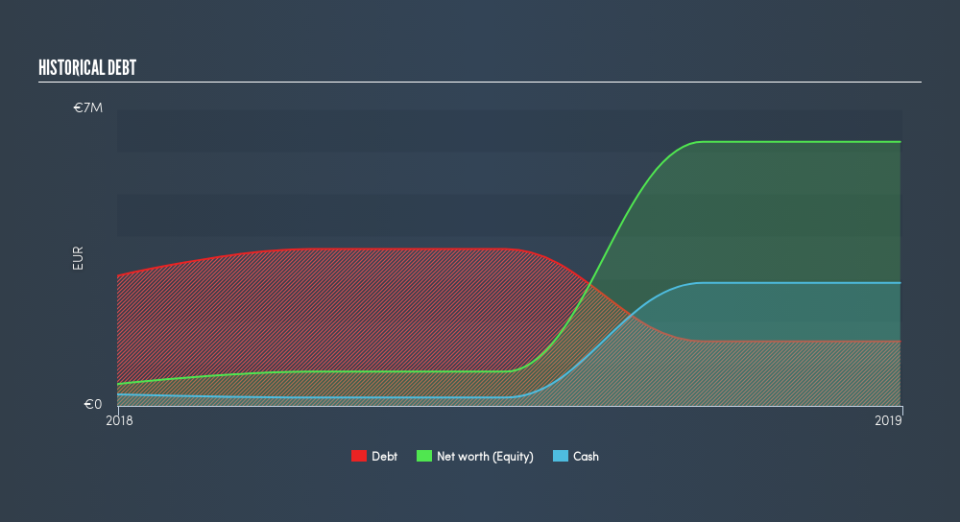Longino & Cardenal (BIT:LON) Has A Pretty Healthy Balance Sheet

Howard Marks put it nicely when he said that, rather than worrying about share price volatility, 'The possibility of permanent loss is the risk I worry about... and every practical investor I know worries about.' When we think about how risky a company is, we always like to look at its use of debt, since debt overload can lead to ruin. We note that Longino & Cardenal S.p.A. (BIT:LON) does have debt on its balance sheet. But is this debt a concern to shareholders?
What Risk Does Debt Bring?
Generally speaking, debt only becomes a real problem when a company can't easily pay it off, either by raising capital or with its own cash flow. Ultimately, if the company can't fulfill its legal obligations to repay debt, shareholders could walk away with nothing. While that is not too common, we often do see indebted companies permanently diluting shareholders because lenders force them to raise capital at a distressed price. Of course, debt can be an important tool in businesses, particularly capital heavy businesses. The first thing to do when considering how much debt a business uses is to look at its cash and debt together.
Check out our latest analysis for Longino & Cardenal
How Much Debt Does Longino & Cardenal Carry?
You can click the graphic below for the historical numbers, but it shows that Longino & Cardenal had €1.53m of debt in December 2018, down from €3.33m, one year before. However, it does have €2.91m in cash offsetting this, leading to net cash of €1.38m.
How Strong Is Longino & Cardenal's Balance Sheet?
The latest balance sheet data shows that Longino & Cardenal had liabilities of €7.52m due within a year, and liabilities of €1.33m falling due after that. On the other hand, it had cash of €2.91m and €7.89m worth of receivables due within a year. So it actually has €1.95m more liquid assets than total liabilities.
This surplus suggests that Longino & Cardenal has a conservative balance sheet, and could probably eliminate its debt without much difficulty. Succinctly put, Longino & Cardenal boasts net cash, so it's fair to say it does not have a heavy debt load!
In addition to that, we're happy to report that Longino & Cardenal has boosted its EBIT by 45%, thus reducing the spectre of future debt repayments. There's no doubt that we learn most about debt from the balance sheet. But ultimately the future profitability of the business will decide if Longino & Cardenal can strengthen its balance sheet over time. So if you're focused on the future you can check out this free report showing analyst profit forecasts.
Finally, a company can only pay off debt with cold hard cash, not accounting profits. While Longino & Cardenal has net cash on its balance sheet, it's still worth taking a look at its ability to convert earnings before interest and tax (EBIT) to free cash flow, to help us understand how quickly it is building (or eroding) that cash balance. In the last two years, Longino & Cardenal's free cash flow amounted to 21% of its EBIT, less than we'd expect. That's not great, when it comes to paying down debt.
Summing up
While it is always sensible to investigate a company's debt, in this case Longino & Cardenal has €1.4m in net cash and a decent-looking balance sheet. And we liked the look of last year's 45% year-on-year EBIT growth. So we don't think Longino & Cardenal's use of debt is risky. Over time, share prices tend to follow earnings per share, so if you're interested in Longino & Cardenal, you may well want to click here to check an interactive graph of its earnings per share history.
If you're interested in investing in businesses that can grow profits without the burden of debt, then check out this free list of growing businesses that have net cash on the balance sheet.
We aim to bring you long-term focused research analysis driven by fundamental data. Note that our analysis may not factor in the latest price-sensitive company announcements or qualitative material.
If you spot an error that warrants correction, please contact the editor at editorial-team@simplywallst.com. This article by Simply Wall St is general in nature. It does not constitute a recommendation to buy or sell any stock, and does not take account of your objectives, or your financial situation. Simply Wall St has no position in the stocks mentioned. Thank you for reading.

